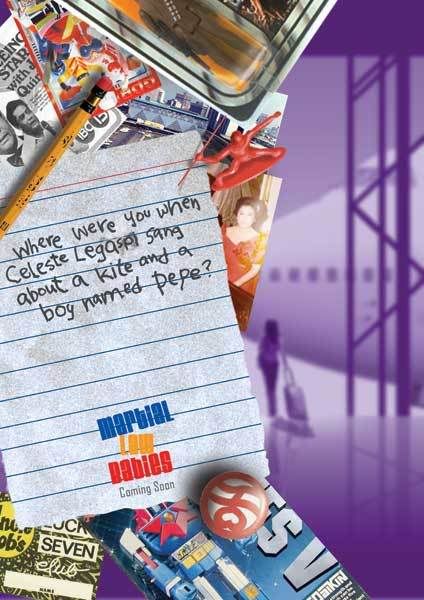Monday, October 27, 2008
 12:41 PM |
No to Proposition 8
12:41 PM |
No to Proposition 8
A simple look at history -- and a cursory look at current events -- would reveal that millions upon millions of people have died or have suffered because of religion. And now, religious fanatics say that I -- and thousands of people like me -- am
the end of civilization as we know it? You have got to be kidding.
Labels: law, queer, rants, religion
[0] This is Where You Bite the Sandwich
Saturday, October 25, 2008
 6:20 PM |
And Now, For Something Completely Different...
6:20 PM |
And Now, For Something Completely Different...
I was told when I got into the set that it was the third hectic day of shooting, but you could not exactly tell that from the boundless energy that embraced the set of
Handumanan*, a new film that has recently wrapped principal photography in Dumaguete. It was a Sunday afternoon, and sometime during the middle of much-needed weekend pampering, I got a text message from director Seymour Sanchez: “We’re shooting now in the Silliman bookstore.”
For real? I texted back.
I had no idea his crew was already in Dumaguete, and a part of me was still delightfully surprised that things were already coming to fruition for his efforts, considering the possible nightmares that can happen in pre-production. “I’m happy,” the director told me, after he had yelled cut for yet another take of
Chin-chin Gutierrez and newcomer
Akihiro Sato alighting from one of the city’s ubiquitous tricycle. “I got what I needed, and I got my dream cast,” which also included Urian Best Actor winner
Jason Abalos.
A few months ago, meeting Seymour for the first time over coffee while he was in town to scout locations and obtain permissions and sponsorships from anyone willing to help out an independent filmmaker, I still could not quite imagine a film being made in Dumaguete.
Dumaguete in film seemed highly unlikely. Like a gimmick. Or a company-sponsored vacation destination where work becomes just another perfect excuse to
lakwatsa. And it always was. Countless television productions come to town to shoot, but never with the place as an integral part of the story: for the most part, the cast and crew come to town to ostensibly work, but really to vacation in some resort around the province. Which is perfectly okay, of course. But I wanted to see a film that had Dumaguete in its heart, the way Donsol and Batanes were in Adolfo Alix’s films, or Batad was in Benjie Garcia’s, or Bacolod was in Peque Gallaga’s seminal
Oro Plata Mata. Think New York in Woody Allen’s or Martin Scorsese’s movies, or Rome in Federico Fellini’s.
When local audiences flocked to see StarCinema’s
Close to You in 2006 to see how the city would be rendered in celluloid, they cheered when they saw scenes set in the Silliman amphitheater and in the seaside Boulevard—but it was Dumaguete as wallpaper, with the setting completely non-essential to the story. It could have been shot in Bacolod (as was originally planned), and nobody would have been the wiser.
There is always the question of the geography of our cinema. Our film heritage has largely taught us that celluloid Philippines lies confined, for the most part, in the business districts of Makati or the slums and grime of Tondo or Payatas. Sometimes, we get Baguio or Cebu or Davao or Boracay or Puerto Princesa (and sometimes such exotic locales as Panglao, Donsol, Vigan, Batad, or Basco)—but Filipino film is largely Manila-centric. For obvious reasons, of course, since the industry is entrenched in the capital. And so, when we sometimes get something like Jeffrey Jeturian’s
Minsan Pa (set in Cebu, and using Cebuano as dialogue) or Cesar Montano’s
Panaghoy sa Suba (set in Bohol, and using Cebuano, too, as dialogue), we get the exquisite thrill of the familiar, and for once we get an affirmation—no matter how silly it may actually seem in hindsight—from popular culture that our own places, our own languages, our own stories do exist beyond the narrow view of Manila.
They’ve made movies in Dumaguete before—but never enough, quite surprisingly, considering Dumaguete’s picturesque setting, its strategic location in Central Visayas that makes it the convenient gateway to surrounding provincial capitals (and assorted backdrops only minutes or hours away from each other), its highly educated workforce, and its more-than-willing community to host film productions of various sorts. (Well, at the very least, the Silliman University community, that is. The local city government can be frustratingly hit-and-miss in this possible area of development, which is sad because a thriving film industry can do well for Dumaguete, where the only other “industry” seems to be academic. Today, it is Cebu that has grabbed that opportunity with its hosting of the
International School of Film and Television in Mactan.)
That Dumaguete is the hometown of National Artist for Film
Eddie Romero should be a plus. By account of local pride, that should prod the city fathers to try to make Dumaguete the cinema capital of Central Philippines. But no. Our city leaders simply lack the imagination, and are always caught up in petty politics to think outside the box.
Many years ago, in the early 1980s, Eddie Romero trooped home to Dumaguete after the success of a string of now-classic films such as
Ganito Kami Noon, Paano Kayo Ngayon (1976),
Banta ng Kahapon (1977), and
Agila (1979) to film
Kamakalawa, a film starring the then-ascendant Christopher de Leon, Chat Silayan, and Tetchie Agbayani, essaying the lead roles in a fantasy story set in pre-colonial Philippines. Although not exactly one of the master’s best, the film is a curious piece of local cinema, and its production still resonate in the memories of those who were here and helped in its making. (My old Filipino teacher in Silliman, it turned out, played Mr. de Leon’s mother.)

I still sometimes wish that the National Artist would come home once more, and make a film here. Perhaps one that can equal the grandeur of
Oro Plata Mata.
After
Kamakalawa, there was nothing as far as I can remember, although Dumaguete did figure in one of those 1980s Regal horror movies as an easy replacement for nearby Siquijor. (Which is laughable.) We can also stretch the definitions of celluloid setting and recall the infamous amateur porn flick
Dumaguete Sex Scandal, which opened the floodgates to geographically-themed local sex films. (Now, that one’s for the books.) Then there was
Close to You, the debut film of Sam Milby, where a significant part of the story is set in the city, which became an instant replacement for Bacolod. (It is said that the filmmakers could not find a suitable spot in Bacolod to film segments set in the Visayas—and immediately decamped to Dumaguete.)
Still, Bacolod today has overtaken Dumaguete as the capital of filmmaking in Negros Island, thanks in large part to the efforts of Peque Gallaga, one of our remaining geniuses from the last golden age of Philippine cinema. Gallaga’s
Oro Plata Mata—an epic story of Occidental Negrense hacendero life under the Japanese during the Second World War—is arguably one of the local filmdom’s best, and there is no equivalent to that set in Oriental. These days, young filmmakers are buzzing out of Bacolod, some of them churning out critically-acclaimed independent films such as
Balay Daku by Jan Philippie V. Carpio (see video clip
here) and
Namets by Jay Abello (see Cinemalayatrailer
here).
And so, when Seymour—who has roots in Dumaguete, and whose uncle is the acclaimed poet Wilfredo Pascua Sanchez—approached me to help him build a network of local people to work with, I jumped at the chance. He said he wanted to do a Dumaguete film, with a typical Dumaguete character: a writer. In this case, a writer (played by Chin-chin Gutierrez) who comes home to deal with mortality, and finally with love. (You have to watch the movie to know the story.)
And now, he has finished shooting here, and will begin post-production soon. Next year would come the finished product, with Dumaguete, finally, as a ticking heart on film. I hope it works. And here’s the best of our wishes to the filmmakers.

With Akihiro Sato in Cafe Antonio

Chin-chin Gutierrez being prepped by a local stylist before a scene

Aki waiting for the set-up to finish

The director planning the next sequence

The crew setting up in Cafe Antonio, inside the Spanish Heritage building
*Handumanan is Cebuano for "remembrance"Labels: celebrity, directors, dumaguete, film, negros
[0] This is Where You Bite the Sandwich
Thursday, October 23, 2008
 5:50 PM |
Chuck and Krip Move on to the Final Round of Man Asian
5:50 PM |
Chuck and Krip Move on to the Final Round of Man Asian
As I had expected (although I admittedly still kinda hoped against hope,
hehehe), yours truly didn't make it to the final round of the
2008 Man Asian Literary Prize, but I am astounded and very happy that two --
TWO! -- Filipinos made it to the short list.
I think this is enough of a stimulus to have the rest of the world start looking into the Philippines and take it seriously as a country brimming with great literature. Here's the press release from the Man Asian organizers:
Kavery Nambisan, Siddharth Dhanvant Shanghvi, Miguel Syjuco, Yu Hua and Alfred A. Yuson are the five authors selected for the shortlist by the judging panel for the 2008 Man Asian Literary Prize, the leading regional prize for a novel unpublished in English. The winner of the prize will be announced on Thursday, 13 November 2008 at a ceremony in Hong Kong.
The five shortlisted works, chosen from a longlist of 21, are Kavery Nambisan (The Story that Must Not be Told), Siddharth Dhanvant Shanghvi (Lost Flamingoes of Bombay), Miguel Syjuco (Ilustrado), Yu Hua (Brothers), and Alfred A. Yuson (The Music Child).
The Right Honourable Adrienne Clarkson, chair of the panel of judges for the prize, said: “All the books breathe with a vibrant sense of what the Asian world is today – modern, yet connected to tradition, aware of change but saturated with the past. I really had the sense that I could feel the living vibrant worlds these novels describe.”
”Reading the shortlisted books, I was struck, above all, by their passionate engagement with contemporary realities in India, China and Philippines. They are primarily concerned, as literary novels must be, with the fate of the individual, but they do not exclude or reduce to a mere backdrop the tumultuous changes in Asian societies. By reckoning with these massive social and political dislocations, they recreate the vitality and urgency of the European novel in the 19th century and Latin American Literature in the 20th. I came away from my reading of the longlisted books thinking that Asia may increasingly provide, to the world's literature as well as to its political economy, the all-important stimulus,” said Pankaj Mishra, one of the three judges.
The winner will receive USD 10,000 and can look forward to publication and wider recognition in the English-reading world. There is additionally a USD 3,000 award for the translator (if any).
The judging panel for the 2008 Man Asian Literary Prize is: Adrienne Clarkson, former Governor General of Canada (Chair); Nicholas Jose, writer, scholar and former Cultural Counsellor at the Australian Embassy in China; and Pankaj Mishra, acclaimed Indian writer and thinker.
The Man Asian Literary Prize was established in 2006 to bring greater worldwide attention to Asian writing and authors. The inaugural prize was awarded in November 2007 to Wolf Totem by Jiang Rong, and which was published in English to great acclaim in early 2008. Several short- and longlisted works of the 2007 Prize have since been published.
Congratulations to Chuck and Sir Krip! And please bring home
that prize.
And now that the pressure is finally off my shoulders, I'm going off to edit -- brutally -- my novel before I send it for possible publication.
Tada!POST-SCRIPT:The Guardian has a story on the short list. Although it focuses on the sole Chinese candidate, it contains quotes from Chuck, and one of them goes: "This whole Man Asian Prize hullabaloo suggests maybe my literary experiments and ideas -- which many people have suggested I compromise but which I refused to - are not misguided. Perhaps now I can share my work with the world. I also hope the Man Asian Prize will help spotlight the writing of my Filipino countrymen."
Amen.
Labels: contests, philippine literature, writers, writing
[0] This is Where You Bite the Sandwich
 1:24 PM |
Thank You for the Responses
1:24 PM |
Thank You for the Responses
It was, in the words of Dr. Mel Vera Cruz, who also happens to be a former teacher (and student) of mine, “appalling.”
She had written to me, like countless of others, feeling that the issue I had written about in the previous column—that of a fellow teacher threatened with assassination if she did not give her students a passing grade—was one of major repercussions in the life of our small city.
A major television network even called, and wanted to do a story. I’m of two minds about this: I am glad that the word has gotten around so effectively—because a widespread awareness of this evil in our midst was one goal of that article; but as a mass communication graduate, I know that news these days has become a commodity, and part of that interest may spring from a journalistic wish to scratch a tabloid-ish itch. Everybody, it seems, loves lapping up stories of the tragedy of other people. My only wish is that some part of that will translate to a form of advocacy or crusade.
The responses I have been receiving from many people seem to be spring from one common source: that of disbelief and outrage. Most of them also believe that the only right to do is to spread awareness. A student of mine, Nethaneel Sagun, wrote in: “ As much as possible let us not be silent about this.” And another reader by the name of Dondi chimes in: “ Really scary and alarming. But at least we’re aware that such atrocities are present in [our] community.”
I appreciate that, if simply because Dumaguete has a dark history of hiding its demons under a carefully managed façade of gentility—”city of gentle people” and all that—effectively shutting out all forms of discussion to address a festering evil. “There are things best left unsaid,” I am constantly told.
So you can only imagine all the festering restlessness frothing under this pressure cooker of “gentility.” Like a volcano really, threatening a future eruption that may surprise us all with particular viciousness.
Some say that eruption has already happened, in perfect Dumaguete slow motion, as we hear news of our city slowly becoming besieged by crime and what-not. It amuses and saddens me sometimes that for all our sugar airs and our “university town” pretensions, dear Dumaguete has become curiously linked to the utmost of sex (in the form of the “Dumaguete Sex Scandal” of some years ago, which is believed to be the mother of all geographically-specific porn made in the Philippines), as well as to the utmost of violence (in the form of the infamous killings in the early 1980s, a tale now reduced to whispers and continued urban legend). June Honculada-Portugal, all the way from New Zealand, writes: “What happened to the ‘gentle people’ in the City of Gentle People? This is unbelievable. I’m glad you wrote about this, Ian.”
There are others, of course. (Click on the comments link in
the previous post to read them.)
Thank you for all the messages of concern. My beleaguered colleague thanks you all as well. And here’s hoping something will be done—and that the dark cloud will soon pass.
Labels: dumaguete, issues, negros
[0] This is Where You Bite the Sandwich
Wednesday, October 22, 2008
 12:59 AM |
Martial Law Babies
12:59 AM |
Martial Law Babies


I should have posted this some time ago, but life got in the way. But here's something to look forward to: a new graphic novel by
Arnold Arre! We've been waiting for this since he published his last work
Ang Mundo ni Andong Agimat (a reworking of Pinoy action
komiks), following the success of
After Eden (a love story),
Trip to Tagaytay (science fiction), and
The Mythology Class (fantasy). I love the way Arnold tries to flex his muscles across various genres -- and this time, with
Martial Law Babies, he is tackling the historical.
You can pre-order the book
here.
Labels: books, comics, writers
[0] This is Where You Bite the Sandwich
Friday, October 17, 2008
 3:17 PM |
Death Threats for Good Grades
3:17 PM |
Death Threats for Good Grades
I’m still debating with myself whether this post should get written. “You be careful, too,” my associate dean told me that Tuesday night when I had frantically texted her and our vice president for academic affairs about a fellow teacher’s deadly predicament.
It was almost midnight, but it felt like an emergency. I told them what happened, and our missives went back and forth in our cellphones. They told me something would be done, but my dread was growing. But I could only imagine the kind of terror my teacher-friend—let’s call her Miss Piñero (not her real name)—was going through: it would be fiercer, I knew, and dark as hell.
Are people really capable of this these days? I asked myself. The whole thing reeked of third-rate crime drama, the ones you see on late night cable television on some B channel nobody watches. And yet there it was: the message was clear, and the intention was deadly, and only a fool could mistake that as a joke and pretend all was well in the world.
The associate dean had good reasons to tell us to be careful: our world had suddenly become such a murderous place, where, for a price, death was easy and terrorism now acquired a domestic and more familiar face. It struck me how easy it was for Evil to swiftly become so ordinary, and so cheap. We all suddenly learned that night that anyone’s life was nothing more than a bargain of P3,000 tops.
And according to the police, that sum was even a little generous. In the station, my beleaguered fellow teacher got told, pointblank: “
Naay uban mopatay ug tawo mas barato pa ana (You can hire people to kill for even less than that),” as if it was the most normal information to impart.
Which, of course, did not calm the nerves of my fellow teacher. Who would after you get told that life was even cheaper than the most-marked down cellphone?
It was already past midnight, and Miss Piñero had gone to the police station to have the incident “blottered,” and the process was taking too slow. Even spelling out her name for the police officer to write down on the form was too excruciatingly slow.
I wasn’t there when she finally passed out. I wasn’t there when she—already suffering from a form of heart condition—was taken to the hospital and admitted. I wasn’t there when she couldn’t speak, when all she could feel was primal fear, of having been violated. Another friend, who was also a fellow teacher, was there, sending many of us missives through cell phones, the midnight crackling with concern.
The next day, I visited her at the hospital, bringing two books she had requested. She looked both weak and strong: the ordeal she bore the night before was clear enough in the way she reclined on her hospital bed—and yet there was also a fierceness in her eyes that said she would not be defeated.
She told me that the night before—after she had seen me in Café Noriter where I was busy checking papers and she was busy tutoring a bunch of Korean girls—she had gone to church for a bit, then went to the department office to get some student papers to mark.
She had decided to walk home, to do some thinking. And that was when she first felt that something was not right. She felt someone was following her in the darkened street, with only a few halogen lamps, standing far apart from each other, providing garish illumination in the lonely early evening stretch that was Hibbard Avenue. Some years ago, she had been accosted on the same street, her bag snatched by some ruffian with all that month’s salary still inside—and so she had some reasons for concern. But she still decided to walk on, until the feeling of being watched was becoming a little too unbearable.
She quickly remembered that that Tuesday was the final deadline for her classes in _________, a special English-writing course designed for the language needs of a particular college. It was a course she liked because it was a challenge for her, and Miss Piñero was the only one in our department who taught it. She is a kindred spirit—and I share with her and some other teachers a standard of learning English that can be very exacting and demanding. Among many student circles, we are basically known as the “terror teachers.” Not because we throw books at students in the classroom, or shout at them, but only because we do not just pay lip service to the “quality education” that Silliman University boasts about. Our mantra is simple: you get a good grade for a good job, and a good job meant requirements submitted on time that passed a certain criteria for excellence. For some students—many of whom mistakenly believe college is something you just have to cruise through—that demand constitutes classroom terrors. We could only sigh and say, “If you want to be spoonfed, go to a diploma mill. Go to a computer college where downpayment is only P1,000 for tuition.”
Miss Piñero is demanding, yes—but observe the way she holds her classes, and you will see that this is one teacher who takes her job seriously. Her comments and suggestions on every single exercise are detailed and helpful, and her dedication extends beyond the ordinary hours of the day. She told me once, “I demand a lot of my students because when I do my work I demand a lot of myself as well.” We used to joke—our heads shaking in commiseration at the same time—that it was almost unbelievable to have students who would submit a paper clearly copy-pasted from the Internet (including hyperlinks printed in blue), and then complain about getting an F. “I submitted, didn’t I?” they would say. And you have to be gentle in reminding them, “Yes, but we grade you for the quality of your work, not for the act of submission.” Miss Piñero had many students like that. In one particular class, she had constant repeaters who could never seem to get it right. One time, Miss Piñero found the tires of her car punctured clean through by a nail—something clearly done deliberately. Later, she would get the following text message that was meant to taunt her: “So, ma’am,
dili na ka kalarga, sa? (Ma’am, just look at the way you can no longer drive.)” She shrugged that message away and went on with her life.
This time, last Tuesday night, it was different. She felt she was being watched. And so she flagged down a tricycle as soon as she could, and arriving home, she found her other cellphone—one meant to receive student messages for instant consultation about class work—vibrating with a new message. Unedited, it read: “we parents decided 2 contrbute 4 u, pls mam kalas na au og mccge ka pnghagbong estudynte or dli imu e.inc, ayw hagbonga o e.inc miski usa sa mga studnts nmu rn, wla me m.himu kung dli mo.amot pra m.wla ka, ur lf only cost 3thou, ma.apil pa gd imu fmly. Mas gas2 pa mn gd p.eskwla kysa pagpatay tawo rn.”
An hour later, another message came: “Try to fail any1 of ur studnts, wer not joking. we just warn u 4 u to be prepared. Also kip quiet, mblis kumalat balita, bka mapa.aga buhay mo nd ur fmly.”
Another hour passed, and the last message came: “By da way, gve ur studnts at least 2.0 in.ordr to pass. Ur vry lucky, we stil gve u a chnce, f u mde a mistake, wer vry sori. Wer on povrty now, got nothn 2 do.”
I will string the death threat in one go, edited this time: “We parents have decided to contribute for somebody to assassinate you. It will only cost us P3,000 for somebody to kill you and your family. We will spend more in tuition if you continue to fail students or give them an INC (incomplete). Do not fail any one of your students. We’re not joking. We just want you to be prepared. Also, keep this quiet because news travels fast, and you will only be inviting death a little early. Give all your students a 2.0 in order to pass. You’re very lucky that we’re giving you this chance. If you make a mistake, we’re very sorry. We’re poor and there is nothing else we can do.”
The tone of the message was clearly serious. That the parts were sent an hour apart meant this was not just some random ravings of a deadline-pressed individual: this was a murderous mind in perfect calculation. It could be a false note. But it could also be true.
It made me mad.
But my fellow teacher, lying on her hospital bed, was philosophical about it: “I can understand their desperation. It is not easy to send somebody to school, only to be rewarded with one failing mark after another. Life is getting hard, and tuitions are getting harder to pay. When you’re desperate, you do whatever you can—even if you have to sink low to get what you want.”
“But poverty doesn’t excuse them to send you death threats like this!” I said.
Is getting the grade you want enough in exchange for your soul? I wondered.
Miss Piñero could only smile sadly. Then she said, “What saddens me is that there is only one way to get a good grade without having to kill someone. And that is to study hard. Is studying too much to ask for these days?”
In an age of instant gratification, I guess it is.
And when I left Miss Piñero to go home, I thought that the classroom is largely a misunderstood place. It should be a place of academic give-and-take. A good teacher starts by giving his or her all—although sometimes, bad teachers can happen. But all that perfect classroom dynamics come to naught when students themselves don’t meet the teacher halfway by showing at least a little enthusiasm, or a little effort to learn something. I remember Miss Piñero once telling me, “I had this student who wrote a paper, and he misspelled this particular word. I encircled it, and noted: ‘Check spelling.’ In the next revision, the word remained misspelled. I encircled it again, and noted: ‘
Please check spelling.’ And in the very next revision, the word
still remained misspelled. This time, I had to check the dictionary to see if it was I who was wrong.” She wasn’t wrong.
The poet Paul Engle used to say, “Even the best teachers can’t make hair grow out of a billiard ball.” It explains a lot of things.
But what if the billiard ball
demands to get a passing grade of 2.0, or else will murder you for it? It now becomes a story of how low this society has become.
Before I left the hospital, I told my fellow teacher I was mad. “I want to write about this,” I said. “But I’m also afraid of these morons’ threats. They want you to keep quiet.”
She looked at me and said, “If I keep quiet, they win. I want you to write about this. That way, they know they’re being watched. That way, we tell the world we’re not cowards.” That way, she said, we stood on the principle that quality and standards must not be mocked and be compromised, even with the deadly promise of bullets.
And that is why I’m writing this. I remember something Edmund Burke once wrote: “All that is necessary for evil to triumph is for good men to do nothing.” I feel this is true for this given moment of crisis. And at least, by God, I know I’m doing something.
Labels: life, rants, teaching
[0] This is Where You Bite the Sandwich
Thursday, October 16, 2008
 9:44 PM |
LitCritters Dumaguete No. 31
9:44 PM |
LitCritters Dumaguete No. 31
 November 1, Saturday
November 1, SaturdayTime Share
by Neil LaButeSecretary
by Mary GaitskillThe Enormous Radio
by John CheeverThe Princess of Nebraska
by Yiyun LiThe
LitCritters is a reading and writing group based in Manila (moderated by
Dean Francis Alfar) and Dumaguete. Every week, we read and discuss several pieces of short fiction from various genres from different writers with the goal of expanding our reading horizons, improving our ability to critique, and learning how to write from the good texts. In addition to speculative fiction, we read Philippine literature in English, as well as world literature. The Dumaguete Group meets every Saturday at 9:30 a.m. at the Silliman University President's Home.
Labels: fiction, LitCritters, literature, silliman, writing
[0] This is Where You Bite the Sandwich
 8:13 PM |
Before the Camera with Mark
8:13 PM |
Before the Camera with Mark
Talk about change in positions. I usually do the behind-the-scenes thing whenever we feel like shooting up a storm of a photo session, but today Mark decided to sharpen his camera chops and placed me in front of the camera instead.
"But, but..." I said. My hesitation did not, would not, stop him. And off he went, styling me, designing the lighting, and positioning me like there was no tomorrow.

At the end of it all, I kinda liked what he took. He has the eye. But trust me, this is going to be last shuffle in this duo. Can't feel too comfortable like this. And Mark
belongs in front of the camera -- and I'll
always be the happy shutterbug.

"At least," I later would say to him, "I have something new to add to my Facebook album."
Labels: facebook, photography
[0] This is Where You Bite the Sandwich
Wednesday, October 15, 2008
 12:19 AM |
Mark Valenzuela and Benjie Ranada Exhibit This Month in Dumaguete
12:19 AM |
Mark Valenzuela and Benjie Ranada Exhibit This Month in Dumaguete

Dumaguete-based artist Mark Valenzuela, who was recently a finalist in the prestigious Ateneo Art Awards, collaborates with Pampanga artist Benjie Ranada for a startlingly original exhibit of terra cotta works and found objects. The exhibit, titled
Juan Revisited/Mask Production, is sponsored by the Silliman University Cultural Affairs Committee, and runs from
October 14 to 31 at the Claire Isabel McGill Luce Auditorium Foyer Gallery.
Labels: art and culture, cultural affairs committee, dumaguete, exhibits, negros, silliman
[0] This is Where You Bite the Sandwich
Saturday, October 11, 2008
 12:32 AM |
Dili Tanang Matagak Mahagbong
12:32 AM |
Dili Tanang Matagak Mahagbong

I find it sad that many in the Philippine literary world do not know the vibrant Cebuano poetry scene that includes the likes of Marjorie Evasco, Cora Almerino, Erlinda Alburo, Merlie Alunan, Ester Tapia, Hope S. Yu, Januar Yap, Myke Obenieta, and Michael Ligalig. One of my favorite Cebuano poets is
Adonis Durado, and this year, he is finally coming out with his first book of Cebuano poetry,
Dili Tanang Matagak Mahagbong (Not All That Drops Falls), with translation by Merlie Alunan.
The launch will be on
October 18, Saturday, at 7:30 pm at the Gallery Q in A.S. Fortuna Street, Mandaue City. It will be a rare fusion of the arts as a show of paintings, sculptures, music, art performances, and poetry readings will be held to celebrate the launching of a local poet's first book of verses. The art exhibit will run until October 30. The multi-awarded poet and graphic designer is set to come home from Bangkok, Thailand, where he is currently working as design director for US-based magazines, for the launch.
Durado, who received the Emmanuel Lacaba Prize from the National Commission for Culture and the Arts in 2000 and "The Best New Writer" award from the Cebuano Studies Center and the Faigao Foundation in 2001, will also exhibit his artworks together with fellow artist-writers Josua Cabrera and Radel Paredes. Cabrera and Paredes will show their paintings, drawings, and ceramic sculptures inspired by the poems of their friend, Durado. Paredes also did the cover illustration for the latter's book.
Here is a sample poem by Adonis, with translation by Ma'am Merlie:
suwat sa sugarol
parts, musta na? nakabuno
kuno atong hiniktang ugis?
idublada akong parte
ugaling itari ni joker
iyang sinyalang buwanting.
debuynason gyud lagi nang
naay gasabak sa panimalay, no?
uy, ni-tip nako si jack
nga kwadro karon iyang chicks.
gisyapulan gyud diay niya
ang kalasera nga sauna
gisuwayan sad nimog dega?
hapit baya to nimo ma-kang,
kung wa pa ka hisakpi
sa financer nimos mahjongan.
pustaanay, matutyo ra na siya?
lisod man nang upat imentin,
labi nag gamay ra kag stopper,
ug imong alas imo rang hitsura.
ang sikreto gud sa pagpangabit
kay naa sa pilde-gana:
dakung dimal kung daghag dama.
maong tagsa-tagsaa og pug-ok
ang baraha aron di dali hisakpan.
likayi sad ang queen diamond
kay ang selosong bana gadalag atsa.
taym pa, niantog kuno nimo
ang ulcer? tabla na diay ta ani:
may lunggong sa kutokuto
kung ugaling masul-an.
barawa na — imni pirmig gatas —
mao nay hirit ni doktora.
mao na nay dibidendo, parts,
kung kita magkatiguwang na.
p.s. damgo nako gabii:
gaturotot nga rayna natikangkang —
4-1-7. irambol lang.
letter from a gambler
howdy, pardner. heard our white
cock won. put my winnings in too
in case joker plays the grey,
that one’s got the marks of a winner.
well, a pregnant woman
in the family brings good luck, eh?
hey, jack tipped me off about
his chicks: he’s got full house, man.
he shuffled, got in good terms
with the lady tip-keeper
you tried yourself before.
almost got her too, i know,
if not for your lady financier
who stalled your mahjong affair.
bet his game plan won’t last.
keeping four mistresses together
is hard to maintain, especially
when you’ve got few stoppers,
and your only ace: your good looks.
the trick of keeping an affair
lies in the game of pilde-gana:
the more you got queens,
the more you lose. so play
your cards well — one at a time,
so you won’t get caught easily.
and stay away from queen diamond
who got a jealous axe-wielding
husband. wait, heard ulcer’s
got you too? that’s two of us now:
shaken dice in the stomach
when it attacks, that’s how it is.
fight it — drink lots of milk —
my lady doctor’s sweet advice.
that’s the pay-off of aging, pardy.
p.s. dreamed last night:
the queen blowing a horn fell on her butt —
4-1-7. just ramble it.
For more details about the event please visit the
website.
[modified from the press release]
Labels: books, philippine literature, writers
[0] This is Where You Bite the Sandwich
Friday, October 10, 2008
 6:57 PM |
100 Wins in Pusan
6:57 PM |
100 Wins in Pusan
When I watched the film during the Closing Night of the Cinemalaya Film Festival in Dumaguete last September, I knew I was beholding something great. And now,
Chris Martinez's
100 just won the KNN Award, which is given to the most popular film from New Currents section of the
Pusan International Film Festival.

Here's a review of the film from a doctor/writer friend (actually a former teacher
and student of mine) which was published last week in the Arts & Culture column of the
Silliman University Cultural Affairs Committee in the weekly
MetroPost...
Things To Do Before You Die...
By Dr. Mel Vera Cruz
That is what the movie 100 is all about. It’s the story of a young woman’s journey—with her family, friends, her pet, and herself—after she was diagnosed to have terminal illness. The theme is somewhat similar to Tuesdays with Morrie [note: this Repertory Philippines play, directed by Baby Barredo, was staged a month before Cinemalaya in the Claire Isabel McGill Luce Auditorium], a play that tackles facing life as one is facing imminent death. But somehow this movie touched me in a way that the play did not.
It’s not because of the actors. Tuesday’s Bart Guingona and Miguel Faustman are definitely better actors than some cast in the movie. But maybe there is the factor of visual appeal; a play is limited by what can be put or conjured on stage, whereas a movie’s possibilities are almost endless.
Also this: one of my complaints about the play is the didacticism, its preachy tone. There were several instances when scenes called for mini-lectures to the audience on how one should live and what things in life really mattered. The film deftly avoids this tendency to lecture but instead brings the viewers on a tag-along trip as the main character lives her remaining days—that is, to the utmost she dreams of. It made me think: if I were in a similar situation, I, too, would probably do what she did.
I think Mylene Dizon’s physique is just perfect for the role of Joyce. Gaunt and willowy, she is grace and composure all throughout. No melodramas for her, only subtlety and quiet talking. That is the nice thing about movies: when the character needs to whisper, she really can whisper, and the camera will capture it. A whisper on stage has to be just that, a stage whisper.
Another major difference between the plots of Tuesdays with Morrie and 100 is the setting. Tuesdays is very American, while 100 is very Filipino. I almost had goose-bumps thinking, Wow, a Filipino wrote this screenplay. Galing! I think director Chris Martinez’s screenplay was able to capture very accurately how Filipinos respond when a family member is diagnosed with cancer. I have seen those exact same responses—the initial hysteria, the almost frantic search for second and third opinions, the turn to Chinese medicine, then a desperate return to religiosity, then pilgrimage to this and that shrine, then faith healing, then “pray-overs” and the like. I’m glad an oncologist was on board in the making of this movie. It makes me wince when the production people do not bother to check if their medical data is accurate and they end up showing medical bloopers on film. Thankfully, not so for this film.
I also like the spic-and-span look of the movie, so in keeping with Joyce’s personality, which is clearly obsessive compulsive, as depicted by her very neat apartment and the no-nonsense handwriting on her perfectly-lined-up-yellow-Post-Its. This is in contrast with the malignant cells growing maniacally inside her body.
There are two scenes in the movie that stand out in my mind when all the other images have begun to fade. First is when Joyce is drawing, one by one, the curtains in her apartment. Her apartment is painted cream, and the curtains are of the same hue. One scene showed her by one window drawing the curtain, and then she would fade, and then she would be by the next window doing the same thing, and then she would fade. And so on and so forth, until all the windows have had their curtains drawn. Then the next shot shows everything in reverse. She is opening windows this time.
The other scene I remember is the death scene. It is very subtle and suggestive, and very artistically done. Before this particular scene, we see how Joyce’s health is deteriorating fast, and she is feverishly finishing up her list of 100 things to do before the fateful day. Towards the end, most of the shots are focused on things going on around her bed, as those closest to her visit and spend time with her. The next scene shows these same people talking among themselves and doing common everyday things, in the terrace and in the living room of her apartment, all of them bathed in bright sunlight. From the shadows of Joyce’s room, a hint of a figure approaches these people, but the figure doesn’t go near them but only looks upon them one last time—in a gaze that lasts for a long time. The light and shadows are very suggestive. It made me think: Joyce is too weak to stand or walk in this last scene so it couldn’t possibly be her physical body that is there. After the long last look, the figure turns and crosses the front of the screen slowly and deliberately. It was quite eerie for me—that play of light and shadow, and then the sight of the figure crossing. At that point, I was actually closing my eyes, because I’m quite scared when it comes to death scenes. But each time I opened my eyes to see if the scene was finished, the figure was still there, crossing ever so slowly—and so now that scene is embedded forever in my memory.
Here are some of the hundred things Joyce wanted to do before she died—tell her mother about her cancer; resign from her job; choose her coffin and wake music; go on an overnight picnic at the beach; go skinny-dipping; eat daing and kamatis; eat ice cream (lots of it); break up an adulterous relationship; give away her material possessions; cook her favorite foods; find a new human for her cat; go to Hongkong Disneyland; go to Europe; sing karaoke in a Malate bar; drive very, very fast; organize her photo albums; spend time with her brother; visit her old high school; talk to her high school crush; plus eighty more things that make up a life.
One thing I haven’t mentioned is that the movie gave me a very good laugh and a very good cry. It was funny and poignant at the same time. Eugene Domingo (as Joyce’s best friend) and Tessie Tomas (as Joyce’s mother) are more well-known to us as comedians—but here they show serious chops as actors. The added benefit of their casting is that their funny scenes look and sound natural, and invites us to appreciate the laugh-out-loud hilarious scenes.
As for the crying, well, it was only natural for so many reasons. For a well-written script, that made me so glad. More movies like this, and I’ll become a movie fan all over again. When I was a kid, my fervent dream was to become a movie-house owner so I could watch movies all the time.
Kudos to 100 for the superb acting. For laudable indie filmmaking. For fine artistry. For the beautiful Claire Isabel McGill Luce Auditorium, as well. And for the idea of making my own list of 100 things to do…
How about you? You want to make one, too?
Congratulations, Chris!
Labels: criticism, directors, dumaguete, festivals, film
[0] This is Where You Bite the Sandwich
Tuesday, October 07, 2008
 4:48 PM |
Orapronobis by Lino Brocka
4:48 PM |
Orapronobis by Lino Brocka
Directed by Lino Brocka. Starring Phillip Salvador, Dina Bonnevie, Gina Alajar, and Bembol Roco.
From
Vincent Canby's review in The New York
Times:
(Orapronobis) Fight for Us is as much a political gesture as it is a political film. Produced by French interests in the Philippines, the movie is the outraged response of its director, Lino Brocka, one of the most popular and successful Philippine film makers, to the human-rights abuses that are reported to be continuing in his country.
The film expresses the disillusionment of those who fought the discredited regime of President Ferdinand E. Marcos, as Mr. Brocka did, with what is seen to be the complicity of President Corazon C. Aquino's Administration in paramilitary campaigns against any citizens suspected of Communist sympathies.
The program notes that accompany Fight for Us, including statements from Amnesty International, are somewhat more arousing than the film itself. They describe case histories of people tortured and murdered by vigilantes, known as the Civilian Home Defense Forces.
The point is that the Aquino regime, especially the members of the armed forces, is conspiring with the vigilantes to liquidate all suspected opposition. The announced target of the vigilantes: members of the New People's Army, the fighting wing of the outlawed Communist Party.
Fight for Us dramatizes the radicalization of one anti-Marcos fighter who, freed from prison after Mrs. Aquino's triumph, returns home only to find his compatriots fighting another, possibly even more insidious oppression.
The story is simply and effectively told, without undue melodrama. The screenplay, the direction and the performances never get in the way of the message, which is intended to alert the rest of the world to what has happened to the dream of democracy promised by Mrs. Aquino. Following the lead of Amnesty, Fight for Us does not directly blame the President, but those of her supporters who are using her revolution for their own ends.
You can also read
the review from Lessons from the School of Inattention by Francis Cruz.
Labels: film
[0] This is Where You Bite the Sandwich
Saturday, October 04, 2008
 11:46 AM |
Sarah Palin Debate Chart
11:46 AM |
Sarah Palin Debate Chart

[from
ph33r and loathing via
andrew sullivan]
Labels: humor, politics
[0] This is Where You Bite the Sandwich
Friday, October 03, 2008
 9:18 PM |
LitCritters, Drunk or Tired
9:18 PM |
LitCritters, Drunk or Tired
The beauty of Facebook is stumbling on the photoshopped shenanigans of people you know. LitCritters Dumaguete (composed mainly of former students of mine) has not met for some time because of the demands of too many things. Sometimes I do wonder about what they do when they're not pouncing on a story. These are two answers...
They go all over the country and get promptly stressed out on the road...

Or they drink to oblivion...

This picture of
Marianne (above, near center, with one eye shut from too much, uhm, Red Horse*) is utterly priceless.
Ehehehehe.*A disclaimer: They will claim this is just a fun photo-shoot for a lampoon issue of The Weekly Sillimanian. Riiigggghhhtttt.Labels: facebook, friends, LitCritters
[0] This is Where You Bite the Sandwich
 8:28 PM |
September of Five Years
8:28 PM |
September of Five Years

I took this photo of you some months ago, in the makeshift studio that was my apartment's small library. Didn't we love that impromptu shoot? And how the pictures seemed to come out so well? The secret, I guess, is to photograph a subject one is intimate with. Look at that face. I've been staring at that face for five years now. There is no end for my fascination, it seems. I can study this face for hours, and find new nuances for every single known expression. Sometimes I also wonder where five years go. Has it been that long? Was there really a time when I didn't know you from Adam, when my days did not begin with an evocation of your name? I still think back to that late afternoon, in September 2003, when we agreed to meet for ice cream.
Oh, baby, that was some ice cream indeed. People joke, of course, that five years is actually fifteen in queer years -- which must make us an aberration, an amusement to some, a model of longevity for others. We laugh at the joke, but we know too well the old bumps in the road to take in readily that fairy tale. We talk about this sometimes: how, for example, we never really thought about the long years, or what it took to stay true. We have learned through the years not to rest easy, both of us. This thing takes work. Patience, too. And a supreme form of understanding for human frailty. All held together by the sheer truth that five years will
not be five years if what is between us is not real. That even when we sometimes get blindsided by stress and work, by damning responsibilities, by the constant temptations preying from everywhere, we know what's real -- and ultimately we know that this is the only thing that matters.
Labels: life, love
[0] This is Where You Bite the Sandwich
Thursday, October 02, 2008
 9:32 PM |
Pawisan sa Magdamag
9:32 PM |
Pawisan sa Magdamag

My latest book,
Pawisan sa Magdamag, is now out in the market, this one written under a pseudonym for Precious Hearts Romance publications. I hope all of you will go out to buy a copy. (I need the royalty fast.) It should be available in National Bookstores everywhere...
[special thanks to
tws for promoting the book]
Labels: books
[0] This is Where You Bite the Sandwich
GO TO OLDER POSTS
GO TO NEWER POSTS

















 12:41 PM |
No to Proposition 8
12:41 PM |
No to Proposition 8
 6:20 PM |
And Now, For Something Completely Different...
6:20 PM |
And Now, For Something Completely Different...






 5:50 PM |
Chuck and Krip Move on to the Final Round of Man Asian
5:50 PM |
Chuck and Krip Move on to the Final Round of Man Asian
 1:24 PM |
Thank You for the Responses
1:24 PM |
Thank You for the Responses
 12:59 AM |
Martial Law Babies
12:59 AM |
Martial Law Babies


 3:17 PM |
Death Threats for Good Grades
3:17 PM |
Death Threats for Good Grades
 9:44 PM |
LitCritters Dumaguete No. 31
9:44 PM |
LitCritters Dumaguete No. 31

 8:13 PM |
Before the Camera with Mark
8:13 PM |
Before the Camera with Mark


 12:19 AM |
Mark Valenzuela and Benjie Ranada Exhibit This Month in Dumaguete
12:19 AM |
Mark Valenzuela and Benjie Ranada Exhibit This Month in Dumaguete

 12:32 AM |
Dili Tanang Matagak Mahagbong
12:32 AM |
Dili Tanang Matagak Mahagbong

 6:57 PM |
100 Wins in Pusan
6:57 PM |
100 Wins in Pusan

 4:48 PM |
Orapronobis by Lino Brocka
4:48 PM |
Orapronobis by Lino Brocka
 11:46 AM |
Sarah Palin Debate Chart
11:46 AM |
Sarah Palin Debate Chart

 9:18 PM |
LitCritters, Drunk or Tired
9:18 PM |
LitCritters, Drunk or Tired


 8:28 PM |
September of Five Years
8:28 PM |
September of Five Years
 I took this photo of you some months ago, in the makeshift studio that was my apartment's small library. Didn't we love that impromptu shoot? And how the pictures seemed to come out so well? The secret, I guess, is to photograph a subject one is intimate with. Look at that face. I've been staring at that face for five years now. There is no end for my fascination, it seems. I can study this face for hours, and find new nuances for every single known expression. Sometimes I also wonder where five years go. Has it been that long? Was there really a time when I didn't know you from Adam, when my days did not begin with an evocation of your name? I still think back to that late afternoon, in September 2003, when we agreed to meet for ice cream. Oh, baby, that was some ice cream indeed. People joke, of course, that five years is actually fifteen in queer years -- which must make us an aberration, an amusement to some, a model of longevity for others. We laugh at the joke, but we know too well the old bumps in the road to take in readily that fairy tale. We talk about this sometimes: how, for example, we never really thought about the long years, or what it took to stay true. We have learned through the years not to rest easy, both of us. This thing takes work. Patience, too. And a supreme form of understanding for human frailty. All held together by the sheer truth that five years will not be five years if what is between us is not real. That even when we sometimes get blindsided by stress and work, by damning responsibilities, by the constant temptations preying from everywhere, we know what's real -- and ultimately we know that this is the only thing that matters.
I took this photo of you some months ago, in the makeshift studio that was my apartment's small library. Didn't we love that impromptu shoot? And how the pictures seemed to come out so well? The secret, I guess, is to photograph a subject one is intimate with. Look at that face. I've been staring at that face for five years now. There is no end for my fascination, it seems. I can study this face for hours, and find new nuances for every single known expression. Sometimes I also wonder where five years go. Has it been that long? Was there really a time when I didn't know you from Adam, when my days did not begin with an evocation of your name? I still think back to that late afternoon, in September 2003, when we agreed to meet for ice cream. Oh, baby, that was some ice cream indeed. People joke, of course, that five years is actually fifteen in queer years -- which must make us an aberration, an amusement to some, a model of longevity for others. We laugh at the joke, but we know too well the old bumps in the road to take in readily that fairy tale. We talk about this sometimes: how, for example, we never really thought about the long years, or what it took to stay true. We have learned through the years not to rest easy, both of us. This thing takes work. Patience, too. And a supreme form of understanding for human frailty. All held together by the sheer truth that five years will not be five years if what is between us is not real. That even when we sometimes get blindsided by stress and work, by damning responsibilities, by the constant temptations preying from everywhere, we know what's real -- and ultimately we know that this is the only thing that matters. 9:32 PM |
Pawisan sa Magdamag
9:32 PM |
Pawisan sa Magdamag
